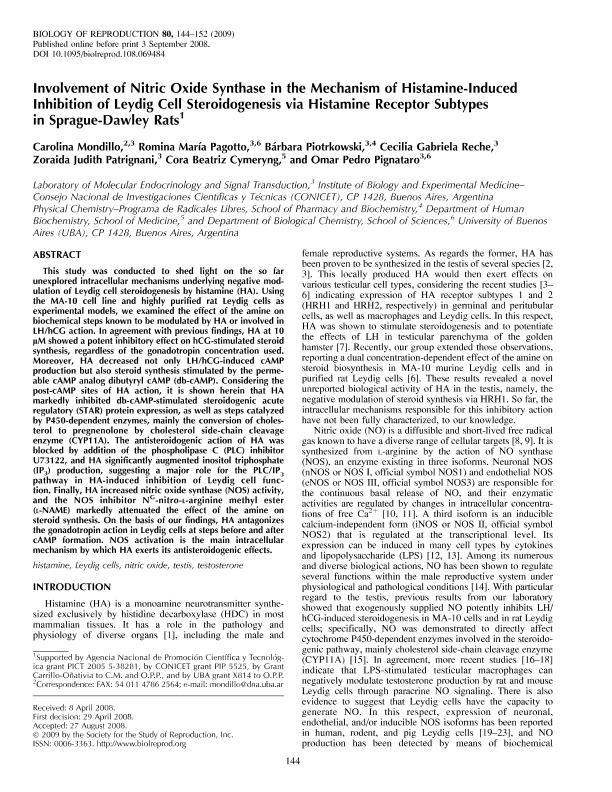Artículo
Involvement of nitric oxide synthase in the mechanism of histamine-induced inhibition of Leydig cell steroidogenesis via histamine receptor subtypes in Sprague-Dawley rats
Mondillo, Carolina ; Pagotto, Romina María del Luján
; Pagotto, Romina María del Luján ; Piotrkowski, Barbara
; Piotrkowski, Barbara ; Reche, Cecilia; Patrignani, Zoraida Judith; Cymeryng, Cora Beatriz; Pignataro, Omar Pedro
; Reche, Cecilia; Patrignani, Zoraida Judith; Cymeryng, Cora Beatriz; Pignataro, Omar Pedro
 ; Pagotto, Romina María del Luján
; Pagotto, Romina María del Luján ; Piotrkowski, Barbara
; Piotrkowski, Barbara ; Reche, Cecilia; Patrignani, Zoraida Judith; Cymeryng, Cora Beatriz; Pignataro, Omar Pedro
; Reche, Cecilia; Patrignani, Zoraida Judith; Cymeryng, Cora Beatriz; Pignataro, Omar Pedro
Fecha de publicación:
01/2009
Editorial:
Society for the Study of Reproduction
Revista:
Biology of Reproduction
ISSN:
0006-3363
e-ISSN:
1529-7268
Idioma:
Inglés
Tipo de recurso:
Artículo publicado
Clasificación temática:
Resumen
The present study was conducted to shed light on the so far unexplored intracellular mechanisms underlying negative modulation of Leydig cell steroidogenesis by histamine (HA). Using the MA-10 cell line and highly purified rat Leydig cells as experimental models, we examined the effect of the amine on biochemical steps known to be modulated by HA, or involved in LH/hCG action. In agreement with previous findings, HA at 10 microM showed a potent inhibitory effect on hCG-stimulated steroid synthesis, regardless of the gonadotropin concentration used. Moreover, HA not only decreased LH/hCG-induced cAMP production but also steroid synthesis stimulated by the permeable cAMP analog dibutyryl cAMP (db-cAMP). Considering the post-cAMP sites of HA action, it is shown herein that HA markedly inhibited db-cAMP-stimulated acute regulatory (STAR) protein expression, as well as steps catalyzed by P450-dependent enzymes, mainly the conversion of cholesterol to pregnenolone by cholesterol side-chain cleavage enzyme (CYP11A). The antisteroidogenic action of HA was blocked by addition of the PLC-inhibitor U73122, and HA significantly augmented IP3 production, suggesting a major role for the PLC/IP3 pathway in HA-induced inhibition of Leydig cell function. Finally, HA increased nitric oxide synthase (NOS) activity, and the NOS inhibitor L-N(G)-nitro-arginine methyl ester (L-NAME) markedly attenuated the effect of the amine on steroid synthesis. On the basis of our findings, HA antagonizes the gonadotropin action in Leydig cells at steps both pre- and post-cAMP formation. NOS activation is the main intracellular mechanism by which HA exerts its antisteroidogenic effects.
Palabras clave:
Nitric Oxide Synthase
,
Histamine
,
Leydig Cells
,
Steroidogenesis
Archivos asociados
Licencia
Identificadores
Colecciones
Articulos(IBYME)
Articulos de INST.DE BIOLOGIA Y MEDICINA EXPERIMENTAL (I)
Articulos de INST.DE BIOLOGIA Y MEDICINA EXPERIMENTAL (I)
Citación
Mondillo, Carolina; Pagotto, Romina María del Luján; Piotrkowski, Barbara; Reche, Cecilia; Patrignani, Zoraida Judith; et al.; Involvement of nitric oxide synthase in the mechanism of histamine-induced inhibition of Leydig cell steroidogenesis via histamine receptor subtypes in Sprague-Dawley rats; Society for the Study of Reproduction; Biology of Reproduction; 80; 1; 1-2009; 144-152
Compartir
Altmétricas



